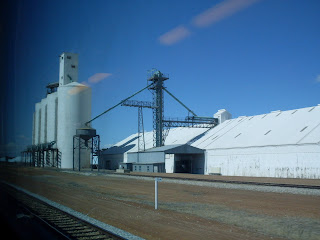I travelled by train from Perth to Kalgoorlie, a distance of around 600km (370 miles) east of Perth and it took about four hours to reach Kalgoorlie station. TransWA runs the passenger service for about AUD $45 for a student fare one way. The area from the Perth metro right up north into the midwest and east to Esperance and the goldfields is called the 'West Australian Wheatbelt'.
It has a land area of over 150,000 km2 and has a population of between 69,000 to 72,000 all spread along this vast area on farms, small towns and outstations. About 15,000 people live in rural towns such as Narembeen, Merriden, Northham and some others more whle the rest live on family farms.
The region is most used for agricuture and it produced two-thirds of WA's wheat production, half of the state's wool production and half of the state's lamb, oranges, honey, watermelon and other agricultural products.



The farm houses look nothing like those on McLeod's Daughters television series on Channel Nine (hahahaha). Instead, they are hot, tough and people really do struggle especially in times of bushfires. There are dogs and sheeps here and there. Farm hands and the odd Toyoto Landcruiser. Along the train route, I can see huge white silos used for grain storage. People from Merriden area often say that huge silos are the largest of their kind in the Southern Hemisphere. I think there must be truth in them since each silo can hold up to 60,000 tonnes of grain. There is a good road system that runs along the towns and most people have to have cars and trucks becasue of the nature of the work and place. The days are hot and dry but are as cold as a freezer during the nights.
WA's golden outback is renowned for its rolling pastures where wheat grow and sheep graze. It is also home to simmering hot salt lakes. One of the problems these rural farmlands face is the problem of salinity. Roads, pathways and plant life have been killed by rising saline ground water. In some places it has formed huge salt lakes that stretch for miles on end.


The Wheatbelt is a huge area and I have not seen most of the places. There is even a place called Wave Rock which is a rocks shaped as towering waves that i would like to visit soon. These pictures show just the places along the TransWA route that I got to see.


No comments:
Post a Comment